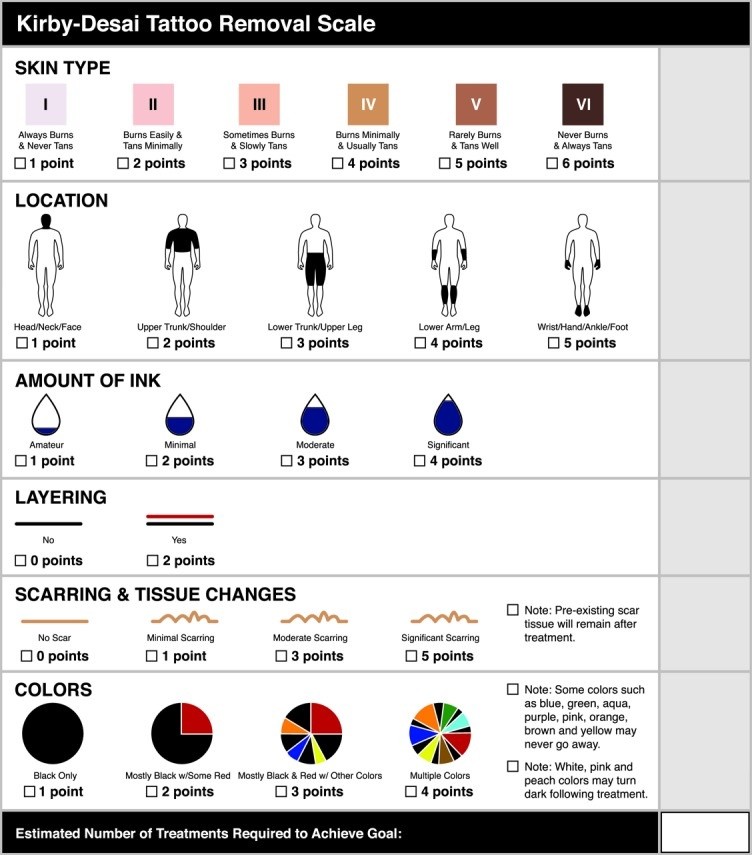How Many Treatments Do I Need For Laser Tattoo Removal?
The Kirby-Desai Scale is an 80% precise tool used by laser technicians worldwide to determine number of treatments needed for successful removal of tattoos.
Simply compare your tattoo with the factors in the tables below, and add up the points as they relate to you.
The scale, named the Kirby-Desai scale, is based on clinical research conducted in 2009 and is said to be 80% accurate.
1. Skin Type: #1 Factor
Your skin type and tone is the most important factor on the Kirby Desai Scale.
We categorize skin tone using the Fitzpatrick Scale, a dermatalogical tool that classifies skin types from 1 – 6. 1 is the lightest.
If you have fair skin, you’ll benefit the most, and require the least amount of treatments.
Patients with darker skin tones need to be treated more carefully, and conservatively. Therefore, more visits are required for best tattoo removal results.
POINTS:
Light/pale: 1
White/fair: 2
Medium/olive: 3
Olive/moderate brown: 4
Brown/dark brown: 5
Black/very dark: 6
2. Location of Tattoo on Your Body
The body location of your ink is a crucial factor.
The areas on your body that respond the best are the head, chest, neck and upper arms.
Why does it matter so much?
These are the parts of your body that receive the most blood flow.
Tattoos near your lymph nodes will also heal and fade quicker.
Areas that have a slower response are furthest from your heart.
Fingers, ankles and feet are spots that generally require more time and visits for optimal results.
POINTS:
Head and neck: 1
Upper trunk (shoulders, chest, upper back): 2
Lower trunk (stomach, lower back, pelvis, glutes): 3
Proximal extremity (above knees & elbows): 4
Distal extremity (hands, feet, ankle, wrist): 5
3. Ink Color(s)
The color of ink in your tattoo is a major factor when calculating tattoo removal treatments.
Darker colours always respond the best, especially black ink and red.
Multi colours will always require the most treatments.
White, yellow, green, beige pigments are pretty much un-treatable by ND:Yag Laser and can be removed with the non-Laser method- Rejuvi.
POINTS:
Black only (greyish/bluish shades): 1
Mostly black with some red (greyish/bluish shades with some reddish/pinkish/purplish): 2
Mostly black and red with other colours: 3
Multiple colours: 4
4. Amount of Ink Density: Pro vs Amateur
The amount of saturation in your ink will have a big impact on your Kirby Desai scale score.
Some pieces require the artist to be quite heavy-handed, tribal is a good example.
These vibrant and dense pieces absorb the laser beam much more than a shaded, low-density tattoo.
Here’s the deal:
Higher ink density needs to be treated more conservatively, thus needing more treatments.
A professional tattoo will require more treatments than a homemade/amateur one.
Pro tattoo artists inject the ink much deeper into the dermis, with a much heavier hand, to produce vibrant & heavily saturated works of art. The ink quality is also much higher.
Homemade tattoos are much easier to treat, due to the exact opposite reasons. The ink sets higher on the skin, and the quality is low.
POINTS:
Amateur: 1
Minimal: 2
Moderate: 3
Significant: 4
5. Scarring and Tissue Change
The process of tattooing or microblading can sometimes cause scarring and tissue change. It all depends on how heavy handed, or aggressive the artist was when injecting the ink.
Tattoos that have scars or tissue change can take longer to remove. These cases typically require more visits for best results.
According to the Kirby-Desai scale study of dermatologists, patients with darker skin tones are more susceptible to scarring after getting a tattoo.
POINTS:
No scar: 0
Minimal: 1
Moderate: 3
Significant: 5
6. Layering and Cover-Ups
A cover-up is defined as a tattoo on top of another one. Many people who’ve experienced regret have gone this route before even considering laser removal.
These cases are often very heavily dense and saturated in nature. This is due to the newer cover-up piece needing to be larger in size to cover up the older one.
The newer tattoo also contains as much as twice the amount of ink in order to effectively conceal the preexisting piece.
An even more extreme example of this would be the new trend of blackout tattoos.
These are becoming more popular as a way to cover old ink with pure, heavily saturated black. No styling design, just pure blackout.
With both of these examples, more tattoo removal treatments are required. It all comes down to the absolute most important factor – Ink density.
POINTS:
Layering – No: 0
Layering – Yes: 2
